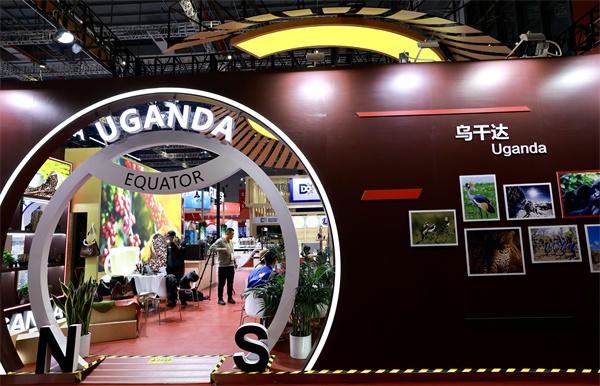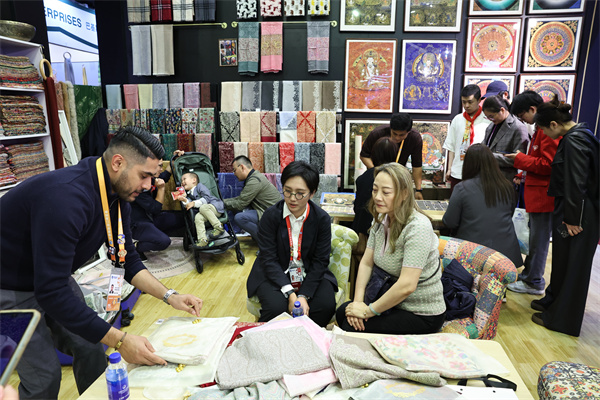The Eighth CIIE proves to be a winning platform for many global specialty products looking to break into the Chinese market, Wang Xin reports in Shanghai.

Global specialties and featured products found their niche in the Chinese market through the Eighth China International Import Expo from Nov 5 to 10 in Shanghai, and sharing the vast opportunities brought by the nation's openness and vigorous consumption.
The Pacific Alpacas Hometex Group, established in Auckland, New Zealand, in 2001, joined the expo, marking the company's sixth anniversary in the Chinese market and its sixth consecutive appearance at the event.
As a longstanding CIIE exhibitor, its booth has expanded from 9 square meters to nearly 120 sq m this year. Featuring products made of alpaca wool and fibers, the company saw its China business grow by over 100 percent on average each year, and expects its sales to exceed 20 million yuan ($2.8 million) this year in China alone, according to Eric Geng Cong, the company's executive director and cofounder.
Describing itself as a company growing alongside the expo, Geng says they are optimistic about China's market potential, where they see consumers increasingly looking for more "good value" and "high quality" products.
Lok Foods from Colombia, known for its chocolate products, is also drawing large crowds at the CIIE.Joining the expo to gain access to the Chinese market in 2021, the company is exhibiting for its fourth time.
The healthy chocolate, with a high cocoa content, has been well-received by Chinese consumers. Moreover, the company has gained inspiration at the expo, rolling out new chocolate products with toppings such as sea salt, caramel and dried fruits.
"The CIIE is the best show I've ever been to in the world. It's also my favorite because I can see the consumers, the new trends, and the whole world here. Chinese consumers are willing to try new flavors and care about their health," says Maria Carolina, CEO and cofounder of Lok Foods.
She adds that the Chinese market now contributes 15 to 18 percent of its total global sales. Orders from China are helping the company improve the lives of more than 2,000 Colombian cocoa farmers.
Similarly, Richard Dolan, joint managing director of Bec Hardy Wines in Australia, called the expo the "largest trade show on the planet". Participating in the expo for the fifth time, this family-owned and operated wine business from South Australia has successfully found its biggest distributors in China at the expo, expanding steadily throughout the vast market.
"The remarkable number of national pavilions, global brands and medium-sized family businesses that come here each year demonstrates that China is the most exciting, dynamic and open market in the world. It has a burgeoning wine industry, and more Chinese people are enjoying premium quality wines," says Dolan.
Swiss Centers, an organizer dedicated to helping Swiss companies enter and thrive in the Chinese market, has been participating in the expo since 2018. Over the eight editions, it has brought over 100 Swiss firms to the trade show. This year, it gathered 36 brands at its cluster booth, with more than one-third being new to China.

"We are known for product quality and reliability, especially for foods and consumer goods. We hope this exposure can help get them new partnerships and also raise their brand awareness in China," says Guillaume Muriset, customer success manager at Swiss Centers China.
Muriset adds that they are seeing a shift in China, which is putting more emphasis on consumption for economic growth, and will offer many opportunities for Swiss brands.
Lucas Oliveira de Sousa, an expert in agribusiness from the Federal University of Mato Grosso in Brazil, is also closely tracking China's policy and market demands. The only company from Brazil with its own booth, Mato Grosso is best known for its agricultural products.
"China is one of our main partners and main buyers of our agricultural products. We want to grow and strengthen our partnership and friendship — not only commercially, but also culturally," says Sousa.
He adds that the company has benefited from China's openness through the expo. Since their first expo appearance in 2023, they have received several Chinese delegations to their home state, many of whom are searching for new opportunities and are ready to invest in Mato Grosso.

"We not only want China to buy our products, such as the soybeans and beef, but we also want to cooperate with China in terms of technology exchange and investment for agriculture, industrialization, and more," he adds.
This also resonates with many CIIE exhibitors from the least-developed countries (LDCs). The expo has offered free booths and favorable policies since 2018 to help boost opportunities in the Chinese market. At this year's expo, 37 LDCs were warmly welcomed, particularly those in the agriculture and food sectors.
Ethiopia's Ambassador to China, Tefera Derbew Yimam, said at a conference during the Eighth CIIE that agriculture remains the backbone of many LDCs' economies. It is the foundation for ensuring food security, creating jobs, and promoting sustainable growth. However, challenges such as limited market access, value chain integration, and technology upgrading, still persist.
"In this regard, China's supportive import policies and major platforms, like the CIIE, have played an instrumental role in enabling agricultural and food products from LDCs to reach the huge Chinese market," he says.
Ethiopia has participated in the expo since 2018. The ambassador notes that many Ethiopian products, such as coffee, sesame, soybeans, beans, spices, flowers, and honey, have been well-received in the Chinese market, and the nation is committed to expanding the trade sector both in volume and value.
Following the success of longstanding exhibitors, the expo is also seeing the wide participation of new participants who look to introduce their specialties to the Chinese market.

Among them is Ernesto Del Rio Bayonesta from Spain. He runs a 50-year-old family business of handmade traditional local foods, such as toast bread, chocolates, biscuits, and pastries, all of which made their China debut at the Eighth CIIE. As promising products in the gifting markets, the young owner hopes to find distributors at the expo to introduce his hometown specialties to Chinese consumers.
Handicraft artists from overseas are also trying to connect with Chinese consumers. Rabindra Kumar Shrestha from Nepal is just one of them.
At a special pavilion celebrating the friendship between Lhasa, capital city of Xizang autonomous region, and Kathmandu of Nepal, Shrestha showcased his exquisite handmade family products related to religious ceremonies at the CIIE.
Shrestha says that it has not been easy, as it usually takes several months for the whole family to create one item, highlighting his gratitude for the friendship, kindness, and help from Lhasa for bringing them to the expo.
"I'm so proud to bring our products to the expo. Everyone is so friendly here," says Shrestha, hoping to find the right buyer for his artworks.
"We start from a small dream, and it is becoming a big dream now," he adds with a smile.


